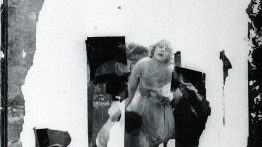COOPERMADE: Reimagined Films

Dubbed “the poet laureate of lost films,” by The New York Times, Bill Morrison A'89 mines film archives to find long-lost footage that he reframes for his own movies, which makes the past feel both unknowable and immediate. His found-footage opus Decasia (2002) is a collage of silent movies found at the Moving Image Research Collections at the University of South Carolina and the Library of Congress. The beauty of the deteriorating images prompted cultural critic Lawrence Wechsler to call Morrison’s aesthetic one of “sublime decay.” Decasia was the first film of the 21st century to be selected to the Library of Congress’ National Film Registry, while his 2013 film The Great Flood earned the Smithsonian Ingenuity Award for historical scholarship.
Morrison, who was the subject of a mid-career retrospective at The Museum of Modern Art in 2014, became interested in a trove of 533 silent movies found discarded under an ice rink in 1978. The site had been a movie palace in the Yukon gold rush town of Dawson City. Using the footage of silent movies long thought to be lost, Morrison crafted a film about the town itself—indigenous people’s loss of land during the gold rush, the image of early 20th century life reflected in the movies themselves, and the fate of the town afterwards. The astonishing result, Dawson City: Frozen Time (2016), was widely recognized as a tour de force of filmmaking about film and was included on over 100 critics’ lists of the top films of 2017. His most recent feature-length doc, The Village Detective: a song cycle (2021), is made from a print of a popular Soviet comedy from 1969 that survived being underwater for 50 years before being found by fishermen off the shores of Iceland. The director used the footage to ask questions about the ephemeral nature of imagery while exploring the history of Soviet films.





